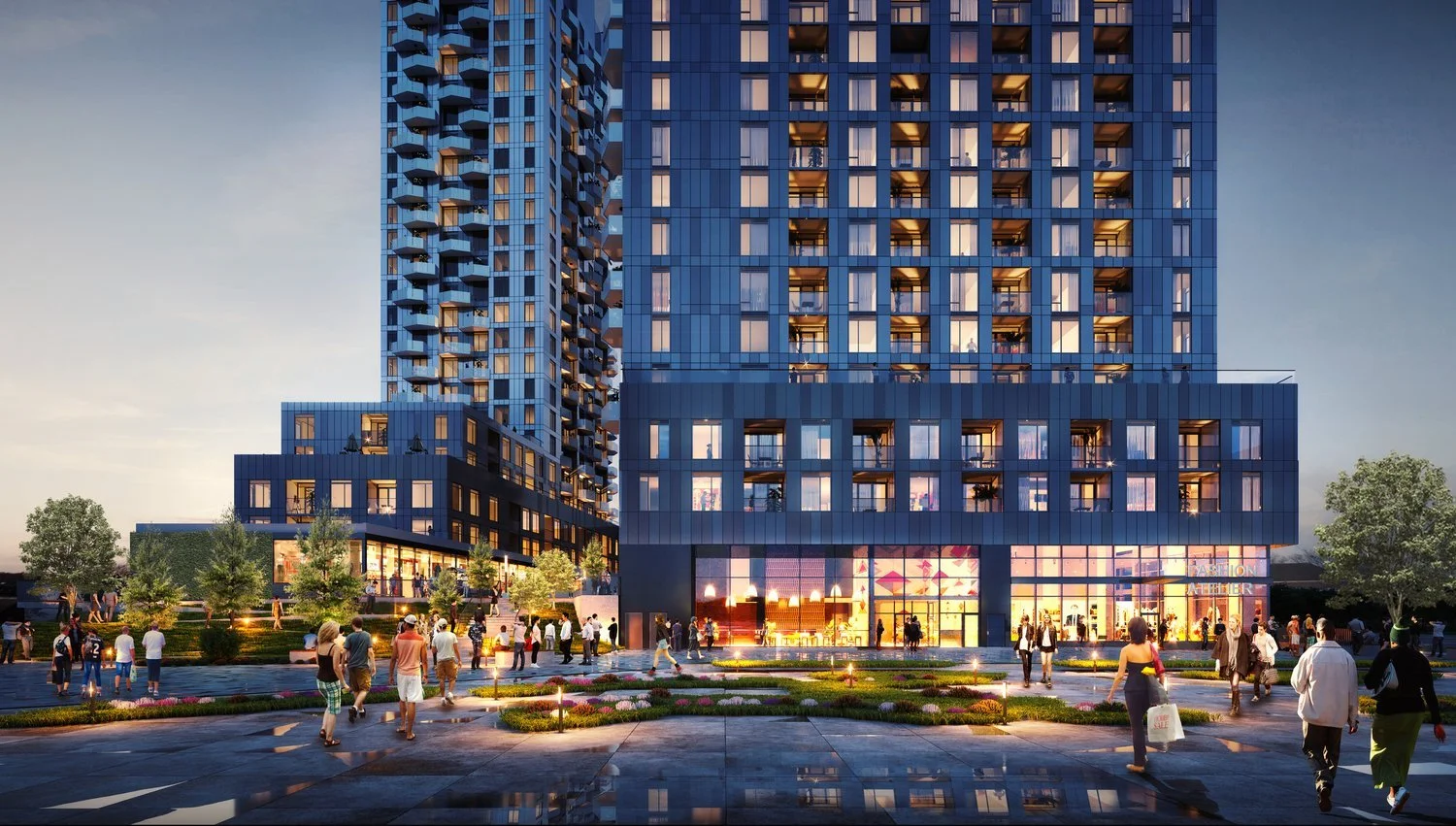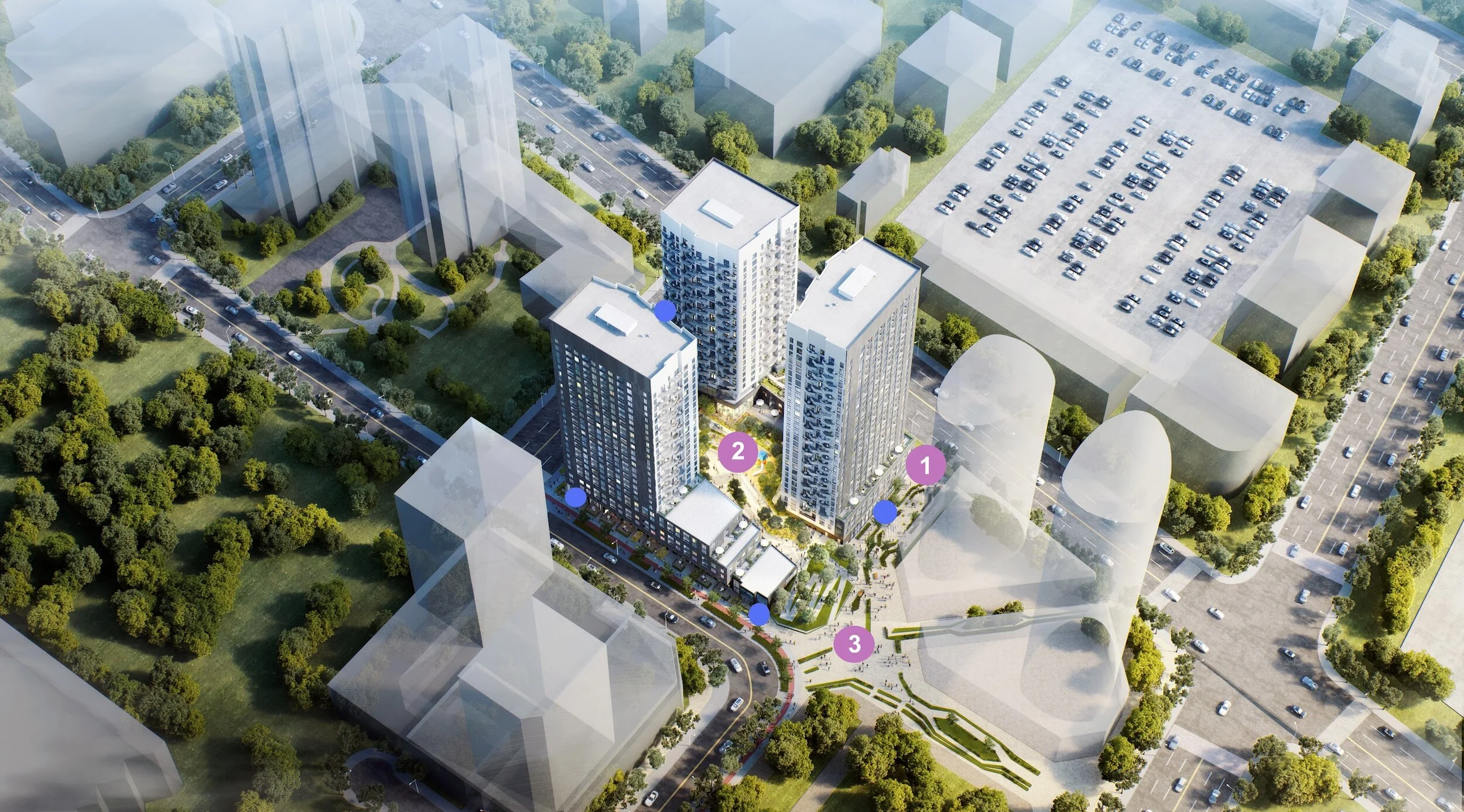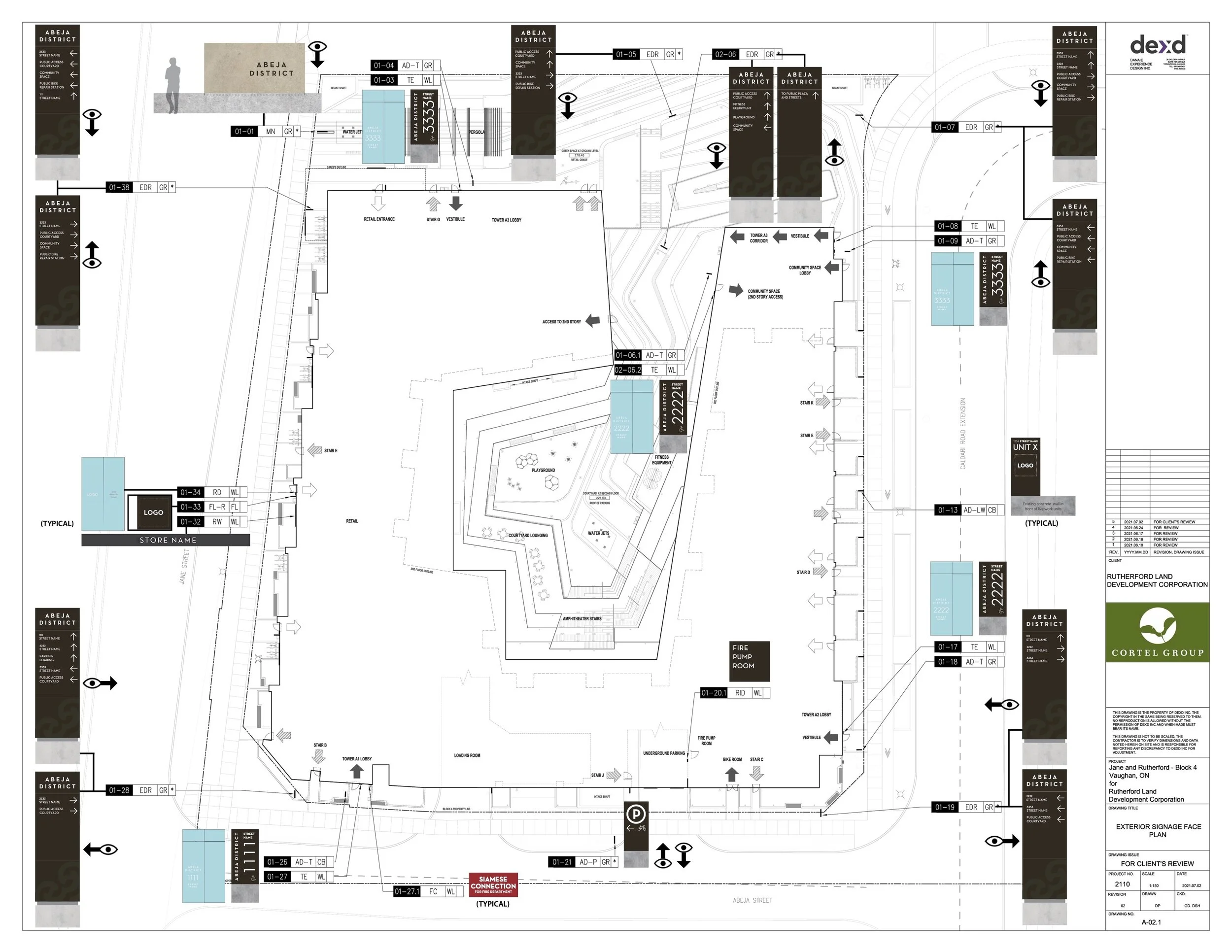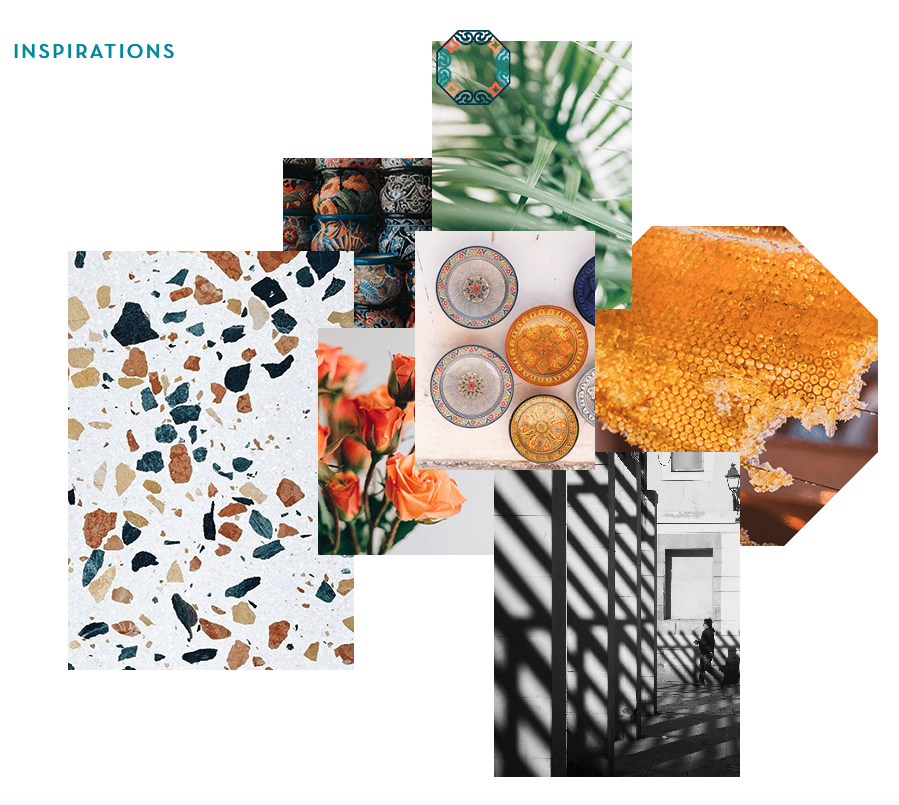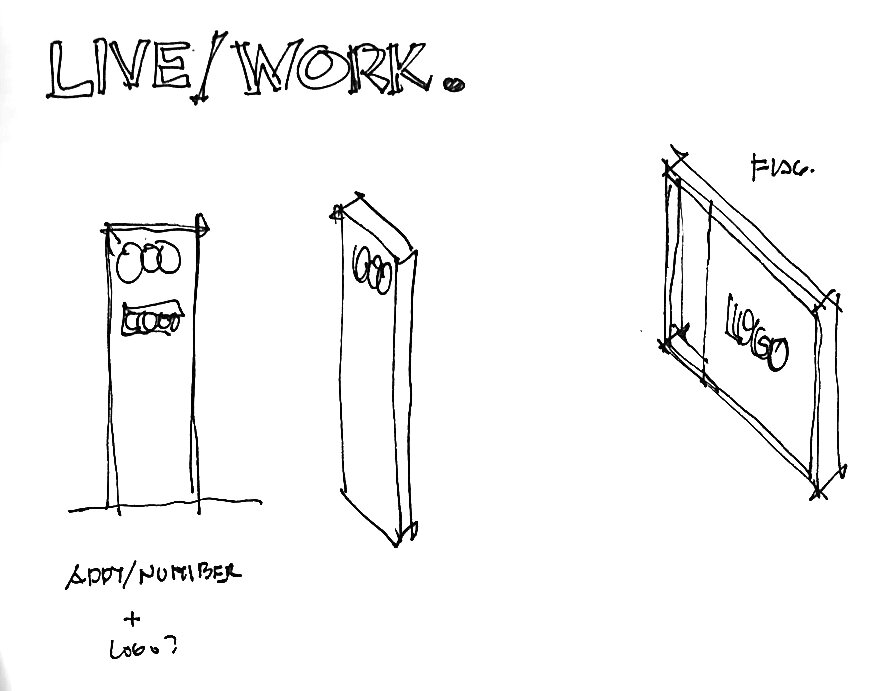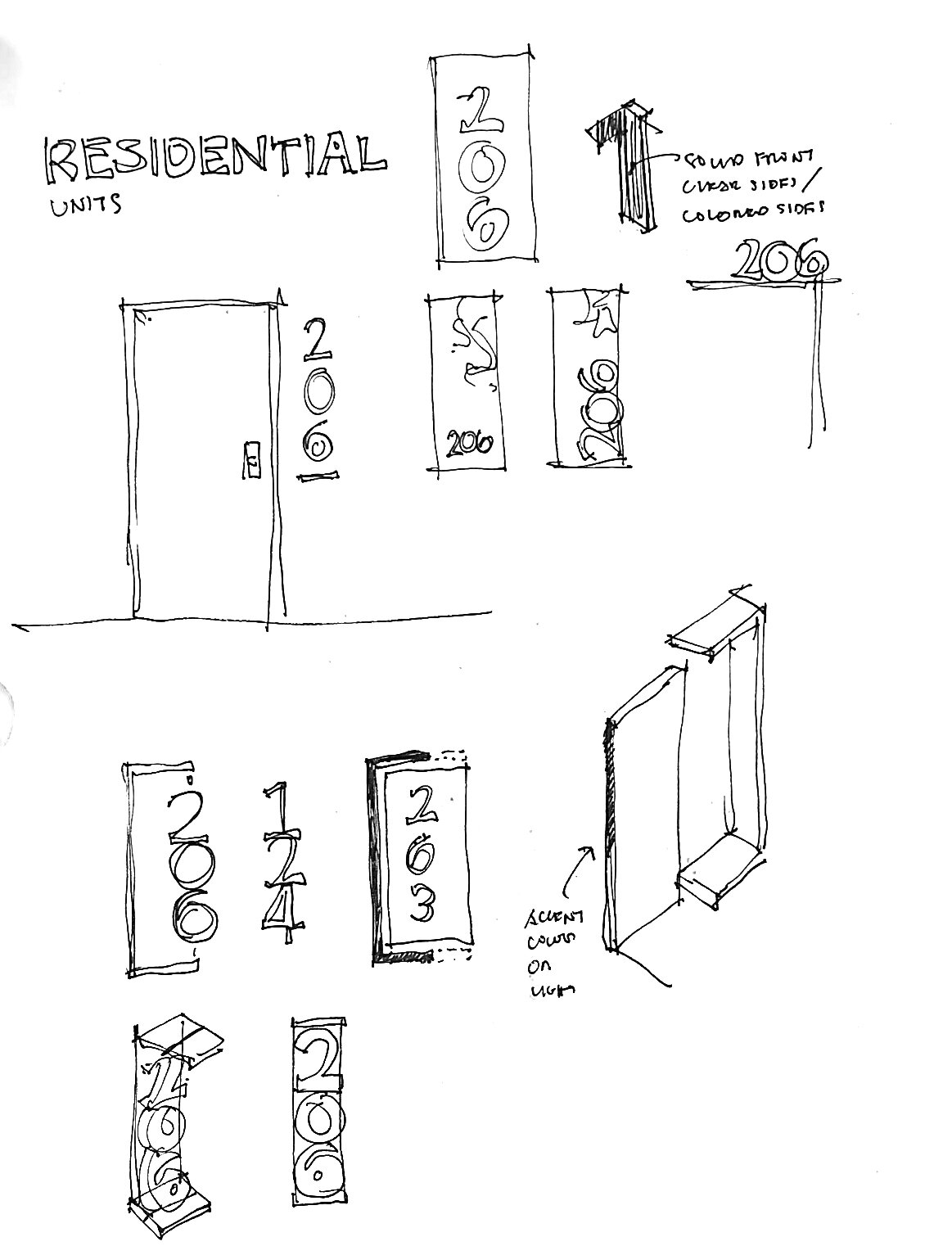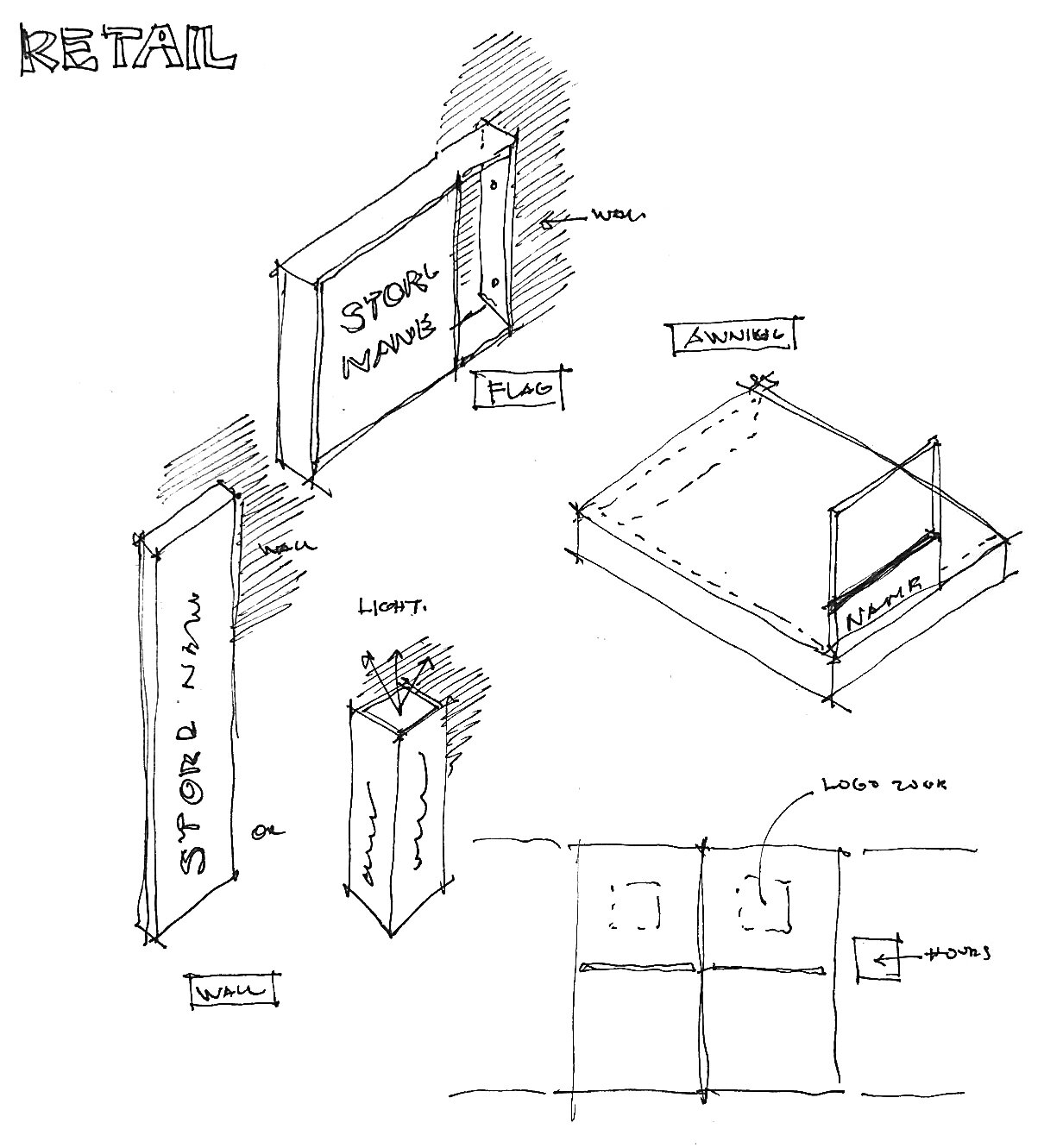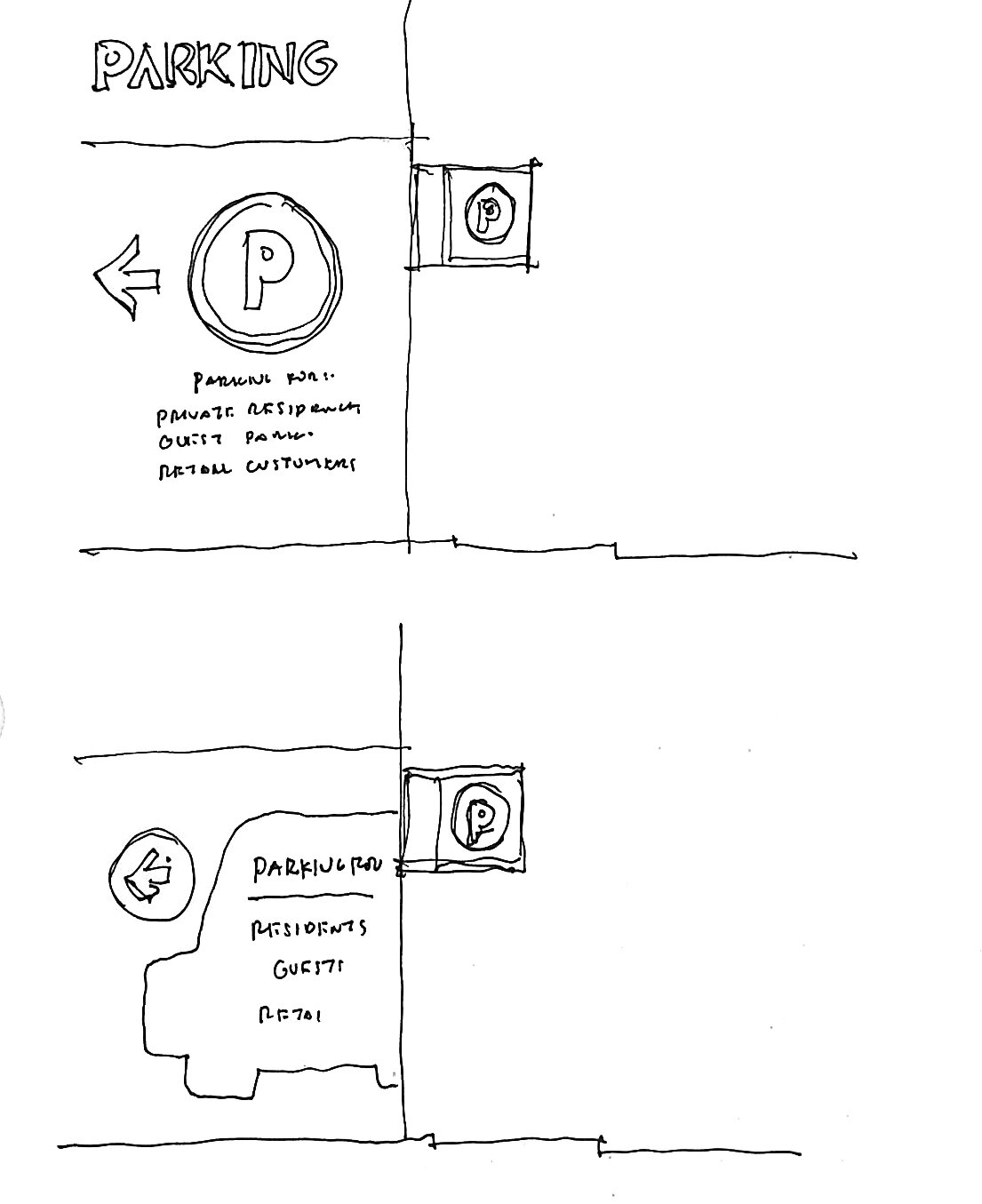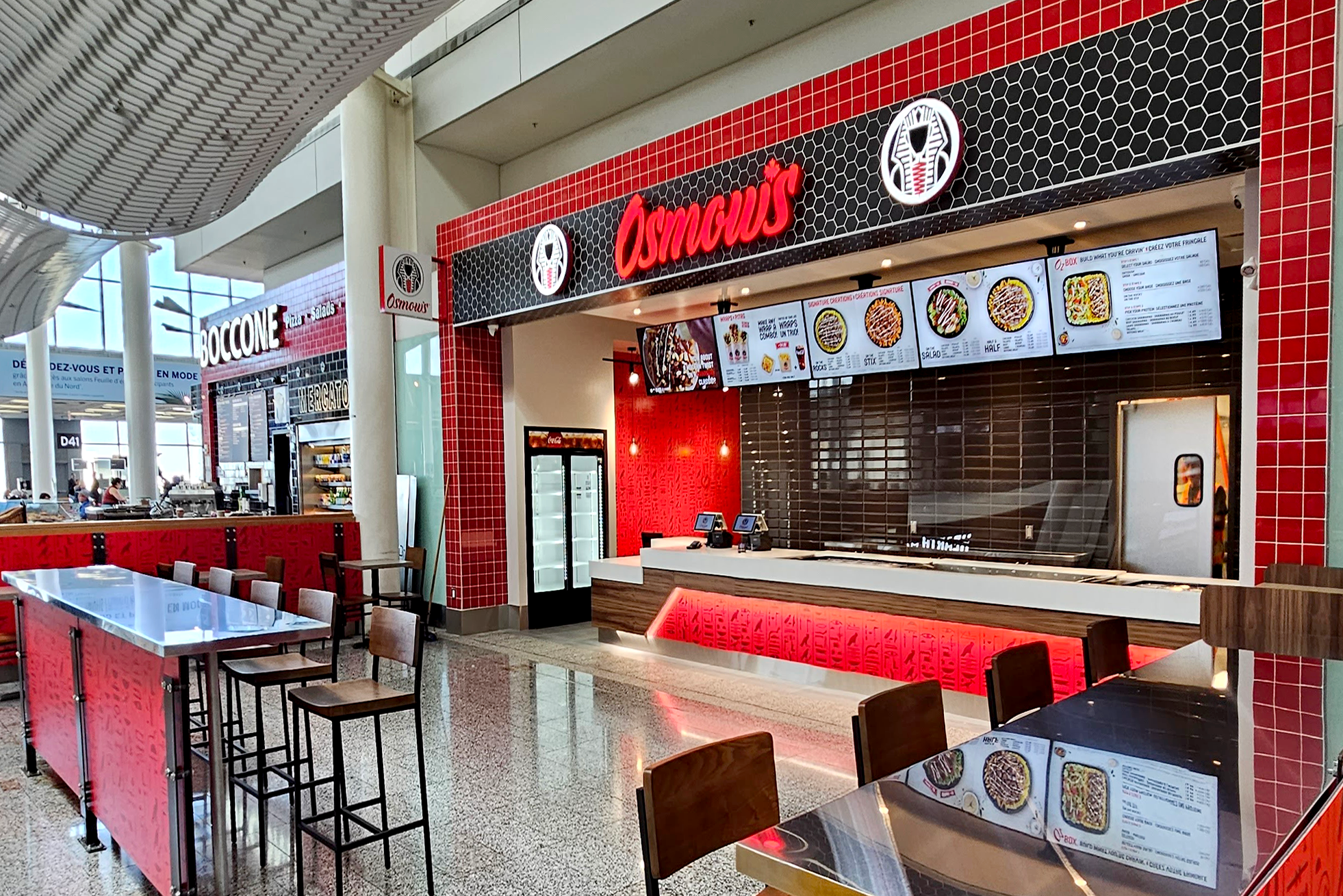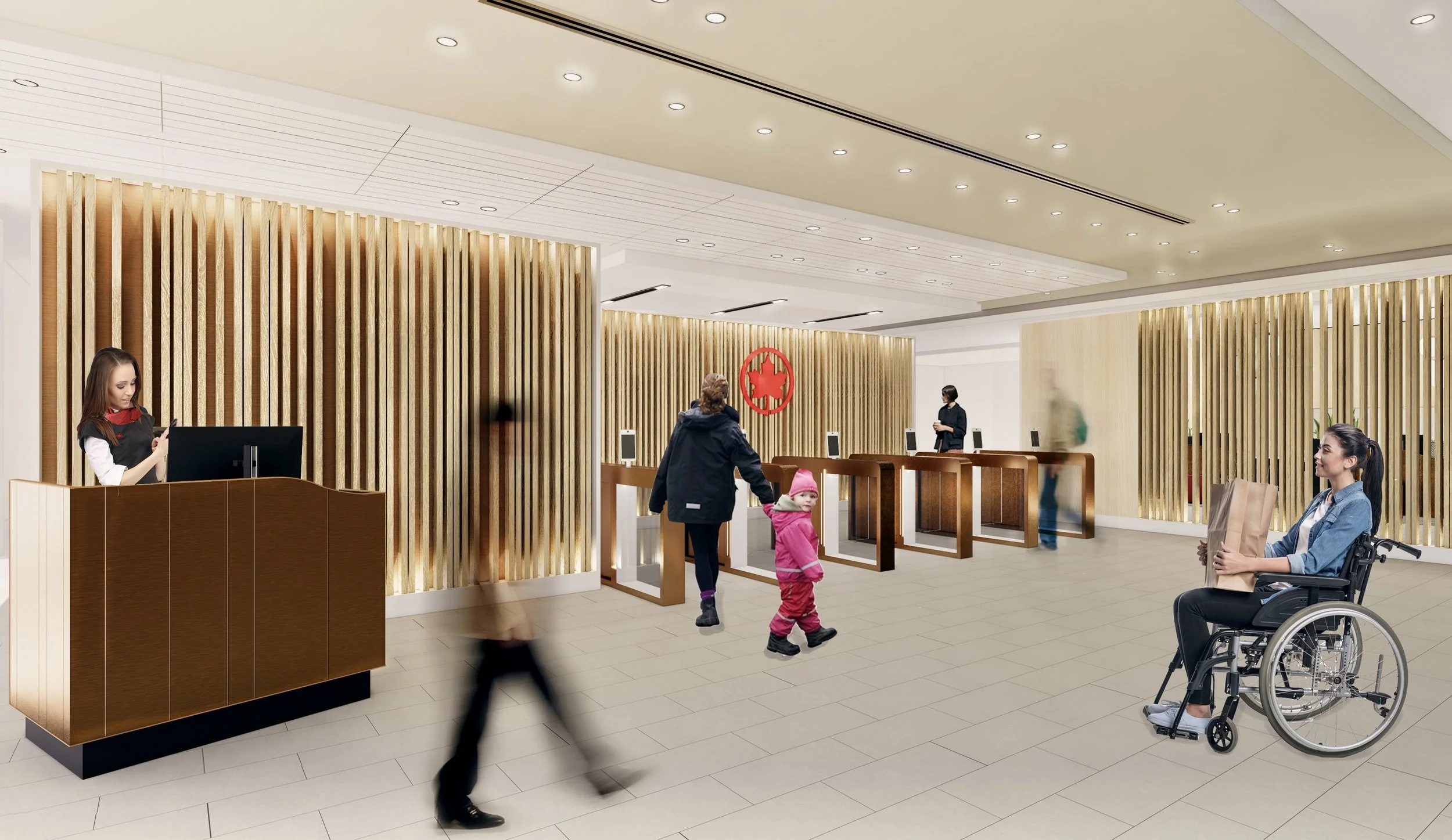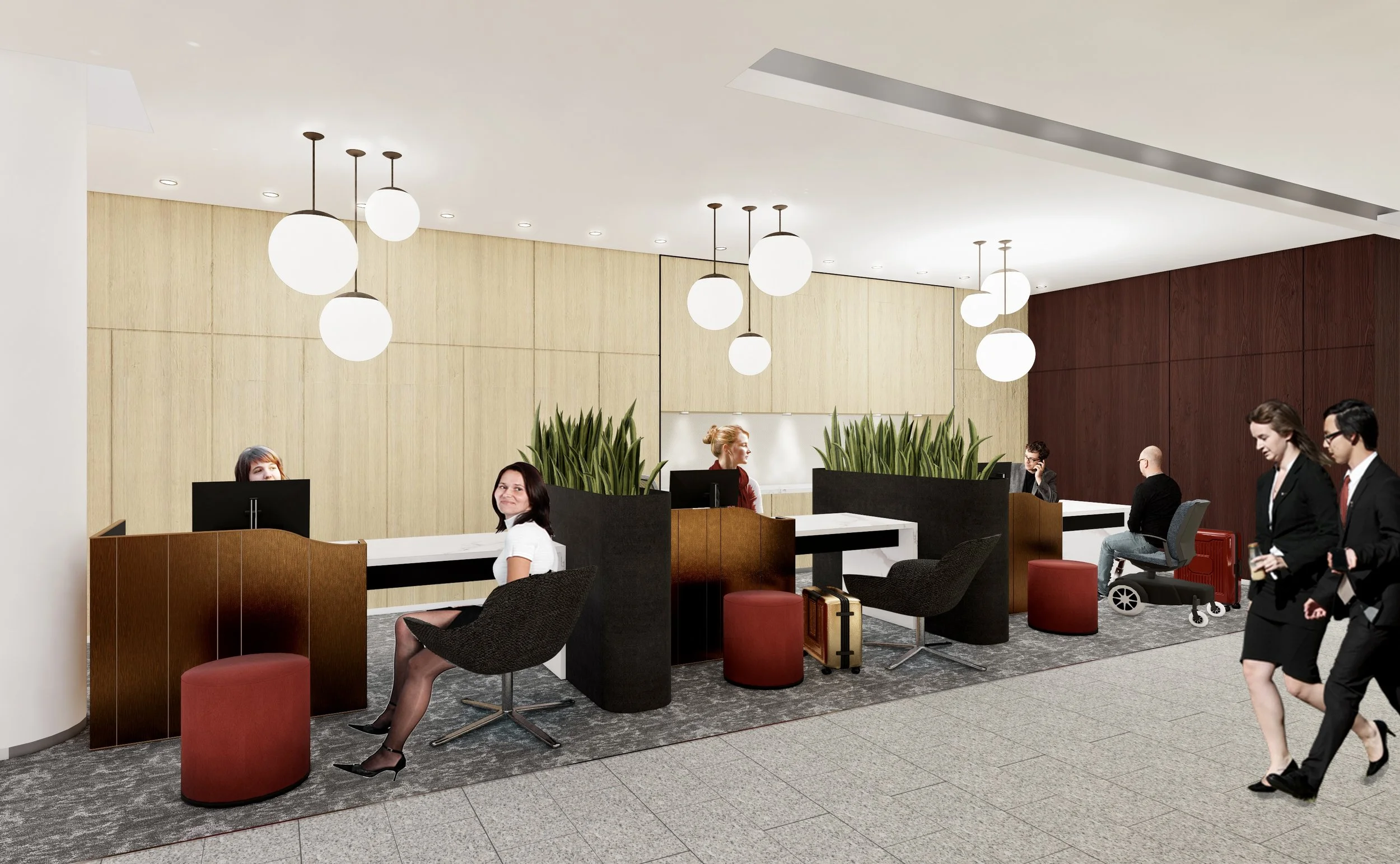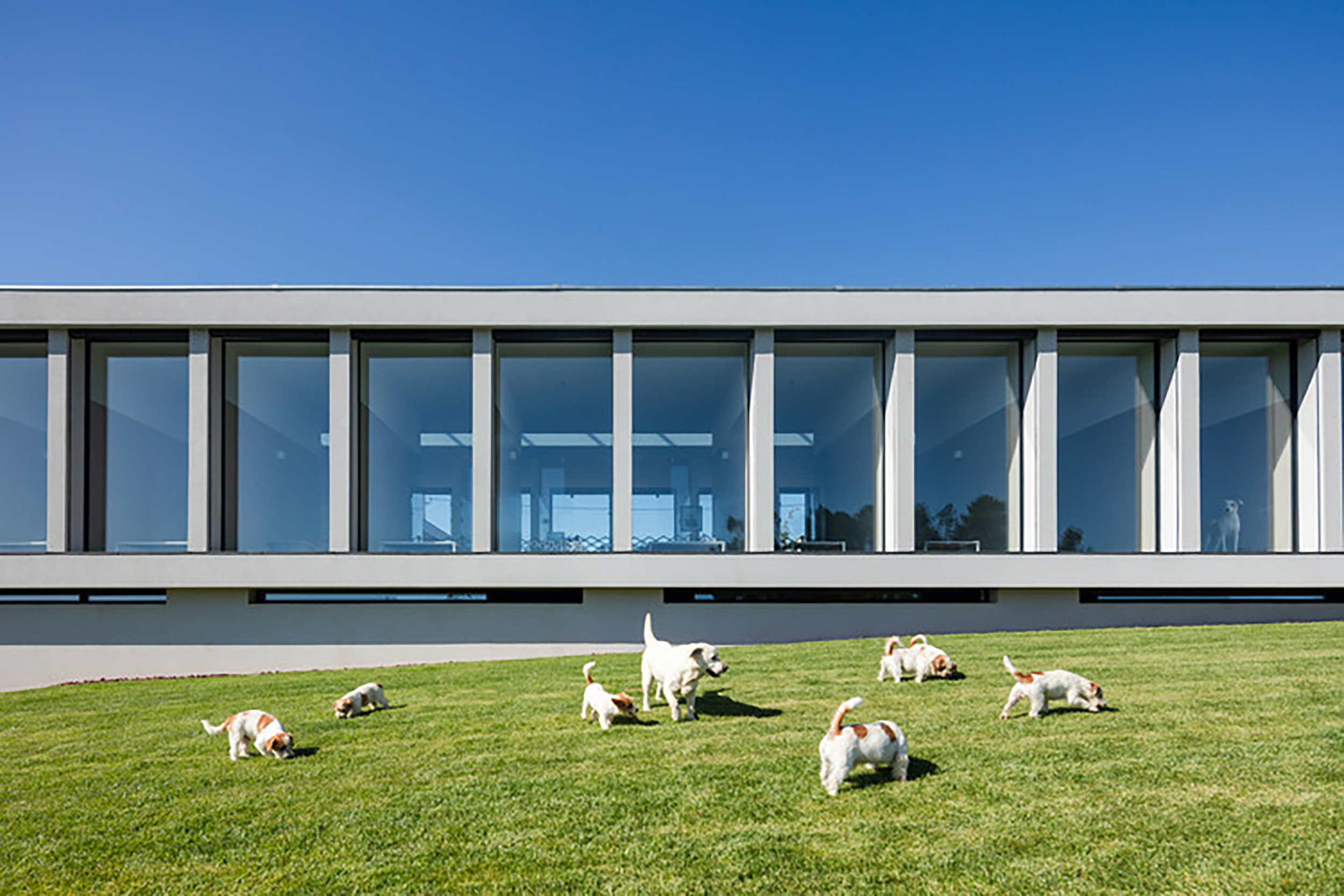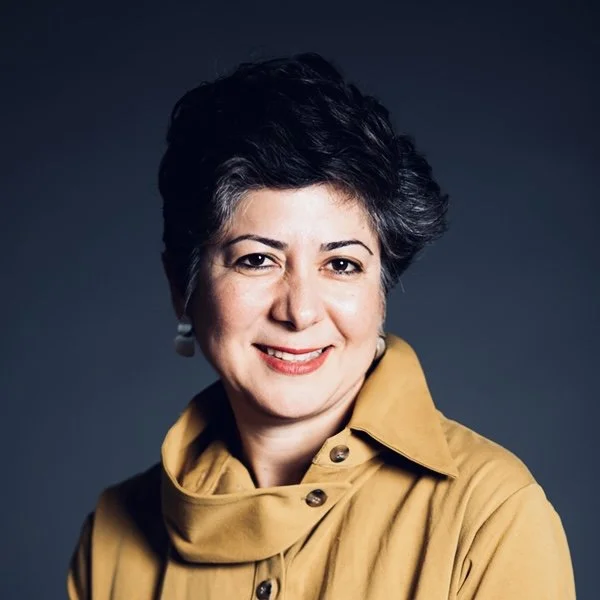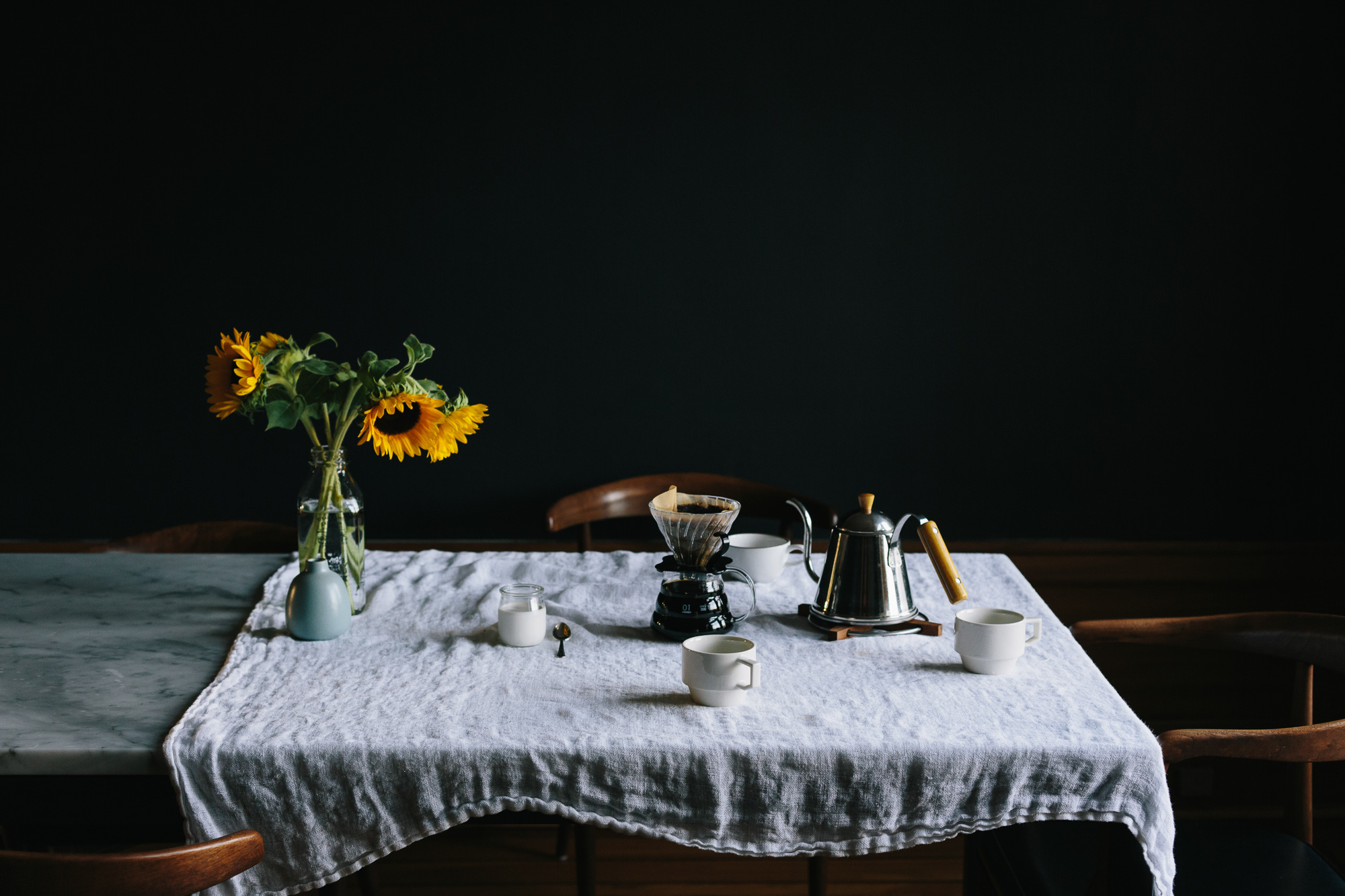
DESIGN BLOG
Thoughts
&
Musings
Abeja District Phase Four, Signage & Wayfinding
A master planned community like no other
Photo Courtesy of BDP Quadrangle
A master planned community like no other
Client: Cortel Group
Design Team: David Schellinger, Gelare Danaie, Daniel Puppin, Karen Zwart Hielema, Matt Ziyaee
Prime Architect: BDP Quadrangle
Project Completion: On-going
The Abeja District Project’s goal is to create a holistic, sustainable community. Located at Jane Street and Rutherford Road, this master-planned development is envisioned as a vibrant hub of life and activity, blending new condos, mixed-use, and commercial spaces into a dynamic urban fabric.
We began our work on the Abeja Wayfinding System for Block Four of the development with three towers, by looking to the larger planning context for the development, encompassing both the parcels under Cortel Group control as well as the surrounding city context.
By documenting the expected master flow patterns for various types of users, we can better understand how people come to the site though public transportation or private vehicles, on foot or on bike. These flow patterns then help us to identify decision nodes, where different users and/or modes may come together, which would most benefit from having strong directional signage, branded experiences as well as public art.
Wayfinding Pyramid
We looked at the different routes that people would take to go between each of the nodes and how the wayfinding can be further enhanced through the views to nodes or the addition of signage elements. Lastly, we looked at the type of character that will be found in the collective spaces, to see where we can further enhance the character through branded environments that incorporate, architecture, landscape, signage, and public art all together. These places are identified as opportunities for what we are calling “placemaking”
1. Certainty (Identity and Code Signage)
2. Navigation (Directional Signage)
3. Delight (Monumental Signage, Branded Environments and Public Art)
Wayfinding and Brand
Abeja district block four is designed with a creative architectural theme which is simple, black with clean lines outside and playful light-colored with a beehive balcony looking inside. After a round of design collaboration meetings with the architects, landscape, and the project team, the decision was to keep the wayfinding graphic design as minimal, simple, and elegant as possible.
Our first design inspiration comes from the overall exterior look for the building, which is rendered in a darker monotone black/blue palate. As such, our signs work with a matte black color for the base of the exterior signs, with white illuminated messaging for increased legibility.
The exterior signs incorporate abstract elements of the Abeja logo in a tone-on-tone contrast to provide a subtle yet rich level of detail without compromising the elegant nature of the signs overall. For feature signs such as our monument sign along the public right of way, we drew inspiration from the Spanish heritage of the development by incorporating large slabs of Spanish Stone (or other similar stones) that are a signature building material of most Spanish architecture.
The interior design character of the building lobbies are rendered in a playful environment with a colorful and textured pallet. As such, our use of the base black signage works well to help stand out from the visual noise and provide clear focus on the directional messaging as much as possible.
Staring Out of Windows
Written and Edited by Suzan Mecitoglu
As the bus follows the familiar route, I can't help but be captivated by the subtle changes that unfold in the neighborhood outside the window. Each day, as I pass by, I notice the little transformations that, piece by piece, shape the character of this city I call home.
A new splash of color on an old building, a vibrant mural adorning a once-dull wall, or a blossoming garden in place of boring concrete – these small changes breathe life into the streets.
Watching these changes through the bus window fills me with a sense of connection to my surroundings. It reminds me that just as this neighborhood grows and evolves, so do I. With every passing day, I cherish the memories of the past while embracing the promises of the future, knowing that change is inevitable and brings new stories to this ever-changing landscape.
With each passing day, I am remined of the power of creativity and the potential for positive change. The possibilities are endless as we work together to build a dynamic city that honors the past while welcoming the promises of the future.
As architects and city dreamers, we can envision endless opportunities to make a meaningful impact on this evolving city.
Princess Hollywood Wayfinding
Client: Cortel Group
Design Team: Gelare Danaie, David Schellinger, Suzan Mecitoglu
Prime Consultant: BDP Quadrangle
Location: Vaughan, ON
Project Completion: On-going
Welcome to the Princess Hollywood, a Signage and Wayfinding system for an exquisite development, designed to embrace community creation.
Located north of Highway 7, west of Creditstone Road, and south of Barnes Court, the complex is adjacent to a major transit hub and highway so that residents and visitors can enjoy convenience and accessibility.
To bring the project vision to life, DEXD team studied how various user types access the site. By understanding their arrival processes, we identified key areas where strategic placement of clear directional signage was required.
Mimicking the architectural design's vision
Drawing inspiration from the building's façade, we focused our design on framing the signs and taking cues from the strong grid structure of the building. The frames are strongly expressed and often offset from the sign face, allowing for a very clean and rectilinear look.
Wayfinding and Brand
Finally, we carefully considered physical signage elements like color, materials, typeface, and iconography, taking inspiration from the brand vision and architectural concept. To achieve a clean aesthetic, we opted for subtle colors that complement the raw and soft exterior concrete.
The use of faux wood, inspired by the wood timber beneath the portico, adds warmth and continuity to the design. Typeface and icons were also meticulously selected to show an elegant and sophisticated ambiance, aligning seamlessly with the building's overall identity and brand image.
How Animals Navigate and Use Wayfinding
Written and Edited by Cody Foo
Wayfinding has been a part of human navigation since people began roaming the world and expanding their territories. The ancient Greeks and Romans started using signs with symbols, rather than using the stars as was custom at the time. Polynesians mastered methods of wayfinding to explore and settle on the islands of the Pacific, many using devices such as the Marshall Islands stick chart. With these skills, some of them were even able to successfully navigate the ocean in addition to their own land.
However, wayfinding is not a human-exclusive technique for navigating, animals of all kinds use wayfinding, from bees using landmarks to find their way home, to birds and sea turtles using the Earth's magnetic field to make their annual migration. Let's look at how some of these animals move within nature.
Bees are vital to our environment given that they continually cross-pollinate crops, allowing humans to produce large amounts of food. It is said that without bees, we as humans would struggle to survive. So how do bees find honey, their hive, and their way around in general? According to Menzel et al (2005) bees use individual "orientation routes" to learn about their surroundings, and then relay this information to the other worker bees. Using elements such as the sun, distance, paths and landmarks, bees are thought to build up a kind of mind map in understanding the relation of the hive to these landmarks.
Ants are another type of insect that always seems to know where they're going; they never seem to crash into each other even when there are hundreds around, and they always seem to have a clear mission and direction. Kohler and Wehner (2005) studied desert ants and found that ants establish outbound and inbound routes, guiding them across their foraging areas. The route-based memories are acquired during the first runs from the nest. Even if the ants are displaced they can find their routes at any place and then follow them home, like human roads. Ants leave behind pheromones that can then be picked up by other members of their colony. Additionally, they can smell in two directions with their antennae and use this trait for navigational purposes.
Besides insects, there are many species of animal that use the Earth's magnetic field to navigate. While the exact method used by each animal is different (and still not totally understood by scientists), animals that are responsive to the geomagnetic field are able to orient themselves like we would with a compass. This allows them to not only find their migratory routes, but also allows predators like foxes to hunt their prey more accurately, using the geomagnetism like a range finder.
References:
Menzel, R., Greggers, U., Smith, A., Berger, S., Brandt, R., Brunke, S., Bundrock, G., Hülse, S., Plümpe, T., Schaupp, F., Schüttler, E., Stach, S., Stindt, J., Stollhoff, N., & Watzl, S. (n.d.). Honey bees navigate according to a map-like spatial memory. Proceedings of the National Academy of Sciences, 102(8), 3040–3045. https://doi.org/10.1073/pnas.0408550102
Kohler, M., & Wehner, R. (2005). Idiosyncratic route-based memories in desert ants, Melophorus bagoti: How do they interact with path-integration vectors? Neurobiology of Learning and Memory, 83(1), 1–12. https://doi.org/10.1016/j.nlm.2004.05.011
Magnetoreception | The Lohmann Lab – University of North Carolina at Chapel Hill. (n.d.). https://lohmannlab.web.unc.edu/magnetoreception/
Let's Harmonize our Buildings with Nature
Written by Suzan Mecitoglu
Edited by Kha Den De / Lera
As I walked past old houses that were about to be replaced by new ones, the words "Save Our Trees" drawn on the walls caught my attention. It reminded me of my favorite architect, Douglas Cardinal, who loved nature and believed buildings should work with nature, not against it.
Douglas Cardinal, known for nature-inspired architecture, valued his native culture, influencing his designs. His buildings blended well with the environment, emphasizing the importance of trees. The flowing shapes reflected his Indigenous heritage, showing harmony between people and surroundings.
Nowadays, there is a tendency to prioritize short-term gains over long-term sustainability. However, the incorporation of Indigenous principles into architecture has the potential to reshape our built environments. By drawing inspiration from nature and recognizing its intrinsic value, architects can create spaces that nurture societies rather than exploit them.
It's crucial to understand that nature isn't just a backdrop; it's vital for our well-being. Each tree and flower contribute to the delicate balance of life. As we advance in architecture, let's acknowledge nature's irreplaceable value.
So, let's prioritize green spaces in our designs, and cherish and protect the trees that make our world a better place. By thoughtfully integrating architecture around nature, we can build a stronger bond with the environment and live in harmony.
As I say goodbye to those homes and trees, I promise to respect nature and support the architects who share these values.
Back to Play
Written by Alisson Talancha
Edited by Kha Den De / Lera
A few days ago, a coworker brought her kid to the office, and as I saw him playing around and swinging in the hammock, I got reminded of the time my parents similarly brought me to their workplace. My parents worked in an industrial workshop space, where I got to create my little world using unplugged machines and office tool as my houses and furniture for my dolls. As a “grown-up”, I have always tried to keep this playful and imaginative part of me present with different degrees of success. So watching this kid play in the office, I couldn't help but wonder, how many adults out there would also like to play around, swing in a hammock or twirl in an office chair?
Well, turns out the answer was closer than I thought. Every day we see how movies like Barbie and Avengers bring childhood excitement to adults. Not to mention 'Disney adults' and other adults having kid-like birthday parties.
I realized most adults want to have fun and keep playing, embrace the childishness and let imagination go wild. Adulthood is not what we thought it is - it’s not just numbers, charts and grey suits. Granted, it’s a bit of that, but it’s also colours, games, fun, sparkles and whatever we decide it is.
Playing has been very important throughout my life, it inspired me to pursue design, through which I hope to bring some joy to people of all ages. It is very important to create opportunities for activation and playing in public. As people involved in the design industry, we hold a privileged position of being able to keep this idea of playfulness alive, bring it to our projects and hopefully make someone's day more joyful.
Pearson Airport Terminal 1 Osmow’s
Client: Royalty General Construction Ltd.
Design Team: Gelare Danaie, Daniel Puppin, Ghazal Mehranpooy
Location: Mississauga, ON
Project Completion: July 2023
Toronto Pearson Airport has welcomed its first Osmow's location at the domestic area of Terminal 1. Opening of this popular chain restaurant is part of the airport's commitment plan to provide exceptional services to all travellers.
As a prime consultant, DEXD was tasked to transform the store into a desired place for customers to enjoy Mediterranean cuisine in a convenient manner. Our team ensured a smooth project delivery within a tight schedule by engaging previously established relationships with the client team, the airport authority, and the general contractor, as well as employing knowledge of airport operation structure and experience in working with the GTAA.
DEXD team provided complete architectural services, including the preparation of Facility Permit Applications for the airport. Throughout the design phase, that started in November 2022, we worked collaboratively with the other consultants to ensure detail coordination. During the implementation phase, completed in July 2023, we supported the construction team by reviewing shop drawings and submittals, as well as responding to RFIs, while keeping the priority of delivering the project within cost and schedule goals.
Abeja District Phase 2 Wayfinding
Abeja District Phase 2 Wayfinding
Client: Cortel Group
Design Team: Gelare Danaie, David Schellinger, Alisson Talancha
Prime Consultant: Turner Fleischer Architects Inc.
Location: Vaughan, ON
Project Completion: On-going
Some Thoughts on Active Transportation
Written and Edited by Kha Den De / Lera
Toronto's transit system is a hot topic for discussion that never reaches a conclusion. We have all been in a situation when the streetcar or bus is delayed by 20 minutes and when it finally comes you have to force yourself in and spend a ride squeezed among other passengers. As someone who has been living in Toronto for a while now, I find myself turning to active modes of transportation more and more, instead of using the TTC. The reasoning is that it is often faster, more enjoyable, and allows some physical activity in a world where we spend most days sitting at work or school.
By definition, active transportation means getting from one place to another using your own power and includes walking, biking, skateboarding, etc. However, the problem with Toronto in particular, is that there are numerous construction works, that often block the sidewalks, and bike lanes are simply nonexistent on many roads.
Such obstacles are often discouraging. As a casual bike user, I sometimes have to choose a half an hour streetcar ride over fifteen minutes biking trip as I am reluctant to bike on a car lane of a busy street. And that is why, I see great potential in developing a better active transportation infrastructure, especially, considering the fact that several Toronto-based initiatives like The Laneway Project and The Green Line have already started to transform underutilized laneways and alleyways into attractive alternative corridors for pedestrians and cyclists through greening and revitalization.
It is important to acknowledge that active transportation is not a viable solution for everyone. For instance, parents with young children, older adults, or differently abled individuals may opt to travel by car. Nonetheless, there is a great number of commuters like myself, who currently travel by car and public transit that could make a switch to active transportation.
Quadra Ingredient Innovation Center
Quadra Ingredient Innovation Center
Client: Quadra Ingredients
Design Team: Gelare Danaie, Karen Zwart Hielema, Kha Den De / Lera, Alisson Talancha
Location: Oakville, ON
Project Completion: On-going
Air Canada Domestic Maple Leaf Lounge E-Gates
Air Canada Domestic Maple Leaf Lounge E-Gates
Client: Air Canada Corporate Real Estate (CRE)
Design Team: Gelare Danaie, Greg Parsons, Karen Zwart Hielema, Daniel Puppin, Ghazal Mehranpooy
Consultant Team:
Code: Elektra Vraches
Mechanical, Electrical, Communications: Quasar Engineering
Structure: Luciano Longo
Size: 1884 square feet
Project Completion: 2023
A focus on enhancing the customer journey through targeted enhancements has transformed the Air Canada Domestic Lounge entry sequence into a seamless and human-centric experience.
DEXD unique design approach uses journey mapping to understand customer profiles and needs. Targeted enhancements include the introduction of e-gates to streamline the entry process for lounge guests. Passengers with additional customer service needs are provided with an enhanced customer service desk experience where a more focused and personalized exchange can take place.
These additions create a more welcoming and inclusive environment, enhancing the overall customer experience as well attention paid to the Air Canada staff experience. Detailed design of the customer service agents’ spaces provides them with a comfortable and functional work environment to deliver exceptional assistance to travelers.
Just Say Hi! What Happens in Public Transit - A Series
Written by Suzan Mecitoglu
Edited by Kha Den De / Lera
Do you frequently ride public transit with the same group of people?
Since I take the bus frequently, I see familiar faces almost every morning. Sometimes it can be awkward because you don't know how to approach a stranger or if they're willing to chat with you. It is essential to strike a balance between being friendly and respecting personal boundaries. I find that a simple and polite greeting like "Good morning" or "Hello" can be a great way to initiate conversation without being intrusive.
When I first moved to Mississauga, I asked a lady to help me make sure I was taking the right bus to get to university. After continuously seeing her throughout the next week I mastered up the courage and started talking to her. Since then, we would have small talks every morning. It created a positive atmosphere on the bus, making daily commute a more pleasant experience for both of us. During Covid we lost our connection but then crossed paths a year later, which was an unexpected but delightful event, that made me feel genuinely happy.
In a similar vein, I've struck up conversations with other commuters just because I see them every day. It is always a smile that initiates a friendly chat. The rush of getting to the destination often makes commute highly stressful and hurried so who would be against a warm informal conversation? Instead of constantly staring at our phones, I believe we could create our own commuter communities by making casual connections with people we meet throughout the course of a typical day. So the next time you're hesitant to start a conversation with a stranger, just say hello and smile. It will surprise you how much better it could make you feel!
Air Canada Transborder Maple Leaf Lounge E-Gates
Air Canada Transborder Maple Leaf Lounge E-Gates
Client: Air Canada Corporate Real Estate (CRE)
Design Team: Gelare Danaie, Greg Parsons, Karen Zwart Hielema, Daniel Puppin, Ghazal Mehranpooy, Suzan Mecitoglu
Consultant Team:
Code: Elektra Vraches
Mechanical, Electrical, Communications: Quasar Engineering
Structure: Luciano Longo
Size: 1722 square feet
Project Completion: 2023
A focus on enhancing the customer journey through targeted enhancements has transformed the Air Canada Domestic Lounge entry sequence into a seamless and human-centric experience.
DEXD unique design approach uses journey mapping to understand customer profiles and needs. Targeted enhancements include the introduction of e-gates to streamline the entry process for lounge guests. Passengers with additional customer service needs are provided with an enhanced customer service desk experience where a more focused and personalized exchange can take place.
These additions create a more welcoming and inclusive environment, enhancing the overall customer experience as well attention paid to the Air Canada staff experience. Detailed design of the customer service agents’ spaces provides them with a comfortable and functional work environment to deliver exceptional assistance to travelers.
People and Places
Written and Edited by Kha Den De / Lera
Every time I find myself in a new place far or close by, whether it is a city or simply a neighbourhood, I feel both thrill and anxiety at the same time: "I am so excited to explore! ... Please let it be fun".
Such mixed feelings are quite common because we believe in a romantic notion of instantly falling in love with a city that is portrayed in many pop-culture movies and books. In reality, however, it takes time for a person to establish connection with a place.
“Cities are, by their definition, full of strangers” - Jane Jacobs
Relationships between people and places are created by... well, other people and places! As you meet people you like and discover places you enjoy, you get more and more attached to them. These touch-points are what make a place - your place.
Hence, people and places exist in an 'eco-system' where one affects another. A good public space brings people together and allows them to connect, which subsequently leads to a creation of community. As people continue to inhabit a space, signifiers of their presence start to appear and alter the character of a space. As such, you and your community become a driving force that initiate changes in the space.
In conclusion, people and places are interconnected more than one might expect. While certain spaces alter one's perception of a place or city in general, characters of those spaces are influenced by its occupants. So if you ever feel like you are falling in love with a place, it would be a fair assumption that you somehow contributed to that place's evolution or change.
Atelier Park Wayfinding
Atelier Park Wayfinding
Client: Cortel Group
Design Team: Gelare Danaie, David Schellinger
Prime Consultant: IBI Group
Location: Vaughan, ON
Project Completion: On-going
The Atelier Park Signage & Wayfinding is a project that captures both graceful design and practical utility that create a smooth customer experience.
Located at the major intersection of Keele Street and Highway 7, Atelier Park is advantageously connected to VMC Subway Station (Vaughan Metropolitan Centre), GO Train line, bus routes, and even pedestrian walkways and green spaces, which outlines the need for clear wayfinding system that would provide clear directions for all users.
DEXD team began the work by producing flow diagrams and documenting expected master flow patterns, which then allowed us to identify decision nodes that would most benefit from having strong directional and/or branded signs, as well as identify best locations for address signs that would be easily pinpointed by users.
Architectural Patterning
As part of our design exploration, we looked into pattern expression and its storytelling potential.
Drawing inspiration from Atelier Park's brand vision that conceptualizes Atelier as designer's workshop or studio, we examined the idea of suit fashion, particularly referring to suit lining. Patterns we considered ranged from subtle but sophisticated to strong and bold-colored. The final design is inspired by the first building to be built within the proposed complex, and its angled faceted elements that run the height of the building facade.
Wayfinding and Brand
Although our design inspiration comes from the brand vision and architectural design, we built on the concept and proposed new colors that would pair nicely with initial brand palette. Typeface and icons were also meticulously selected to match overall elegant feeling of the building and brand.
Animal Sounds and Multicultural Experience
Written by Alisson Talancha
Edited by Kha Den De / Lera
As someone who lives alone, I realized that working remotely is not all that fun. Not only you start feeling lonely but isolation also rusts your social skills. Back in February, DEXD team moved to a new office. We went from a hybrid schedule of seeing each other once every other week to sharing the space every single day from 9 to 5. Since many of us were relatively new to the company, lunch breaks were filled with extensive weather discussions and awkward staring at each other in silence.
That's when out of desperation I asked: "What do dogs say in your language?"
As a native Spanish-speaking person I always thought dogs say "wau" ("guau" in Spanish). But after starting to learn English I found out that English-speakers use "woof" to describe dog sound. This discovery made me curious, how come universal animal sounds are interpreted differently in each language?
Although this question should probably be intended to a linguist, something amazing happened when I inquired about the subject. I found out that in Turkish dogs say "hav hav," in Farsi "vak vak," in Russian "gav gav," and in Korean "meongmeong". However, the best unintended consequence of my question was that suddenly we were all engaged in a lively conversation about this silly topic, breaking the ice and allowing us to be more social.
This experience with my coworkers also made me think about how we interpret things differently depending on our backgrounds. Whether it's a fun conversation about animal sounds or a complex work subject, having various unique perspectives can be game-changing. The multicultural environment that we exist in, provides us with an extremely valuable opportunity to learn and exchange ideas, which is impossible in a different setting.
*For those who are still curious, I also discovered that roosters do not only say "kikiriki" as my Spanish-speaking mind thought, but in French, they say "cocorico," in Farsi, they say "kukuku," in Russian, they say "kukareku" and in Turkish they say "ü-ürü-üüü". Cats, however, seem to be the clearest in their diction, as in Spanish they say "Miau," in English "Meow," and in many languages, they have a similar "meow" sound.
Gelare Danaie
Founder, Partner
Founder, Partner
Who I Am: I grew up in a house full of books, music, and culture. I decided to become an architect at a young age. I believe every place has a story to tell, and my passion is to create memorable experiences in built-environment. I love listening to client’s stories, observing their daily lives, and learning from them. I have lived and worked in four cities across four continents and this has helped me reframe my perspective of life; I am always learning. When I am not working, you can find me skiing with my family, paddle-boarding, running with my dog, sketching in my notebooks, or reading and writing fiction.
What I Do: I have been in architectural business for more than two decades designing different types of buildings. My approach to architectural design has evolved over the years - I have moved from creating forms and structural compositions to designing human experience. I am an entrepreneur and enjoy running businesses. Understanding the clients' needs and serving with authenticity and integrity while concentrating on progression and continuity are my new venture's goals. I enjoy the process of creative design and co-creating experiences with our team.
Karen Zwart Hielema
Partner
Partner
Who I Am: As a true collaborator and team player at heart, I am happiest when I am working on projects where I am learning something new and engaging with people from different backgrounds, disciplines, and skill sets. These collaborations bring satisfying and rewarding results. A common thread throughout my life has been my connection and passion for the arts. From early play and experimentation, and throughout my schooling and profession. I also gravitate towards organization and detail as part of my process. These attributes serve me well in my Architectural practice and the project work I am involved with. Art inspires me, is a way to express myself and encourages me to think big and wide and explore the boundaries. My tendencies towards organization and management help me keep track of an array of team input while staying focused on bringing the collective goals of a project to completion.
What I Do: I am an architect with over 17 years in the industry working across a variety of both public and private sectors including Healthcare, Arts & Exhibition, Transit, Airports & Aviation, Commercial/Retail, Corporate/Office, Education, and Warehouse/Light Industrial. Throughout my career I have intuitively taken on leadership roles on large and complex architectural projects, guiding teams to seek out opportunities to collaborate across disciplines. A special interest for integrated arts and exhibitions brings me fresh perspective and insights towards alternate ways of design thinking, conveying information, and achieving vibrant and purposeful public space. I approach projects from the perspective of one’s journey and experience, involving meaningful engagement with users, stakeholders, clients and consultant groups to bring a project to fruition. Through this process, projects emerge with fulfilling results made possible when a broader cross-disciplinary team offers the best possible outcome.
Ramin Beyraghdar
Business Development Manager
Business Development Manager
Who I Am: As an experienced architect with over 20 years in the field, my experience has gently steered me towards a broader understanding of design. It's not just the structures we build, but also the relationships and connections they foster. My passion lies in bringing people together, whether through collaborative projects, engaging conversations, or simply by creating spaces that encourage interaction and understanding.
What I Do: At DEXD, I lead business development efforts by building reliable relationships, identifying growth opportunities, and shaping strategies that connect design with human experience. My work focuses on expanding our network, nurturing partnerships, and aligning our services with the evolving needs of clients and communities.
Ghazal Mehranpooy
Project Manager
Project Manager
Who I Am: I grew up in a house that was built by my grandfather who was an amazing Architect, and since the time I know myself, I wanted to be a successful Architect just like him. My passion for innovation drove me to push boundaries, constantly seeking new ways to harmonize the built environment with the natural world. I love to design spaces that inspire, uplift, and evoke emotion. I believe architects possess the ability to transform mere structures into living, weaving stories that resonate with the souls of those who inhabit them.
What I Do: I have been in the architectural field for more than 12 years with various experiences in residential, commercial, office, and hotels from the design phase to the production phase. I combine my artistic flair, technical expertise, and project management skills to create functional, aesthetically pleasing, and sustainable spaces that enrich the lives of people and contribute to the fabric of our society.


